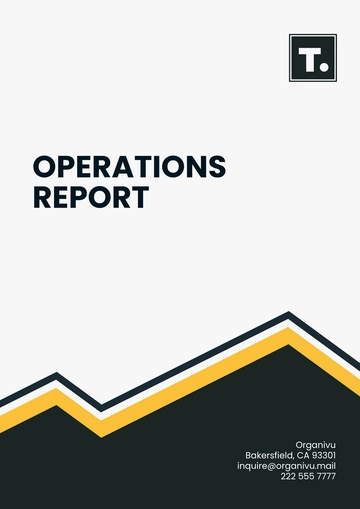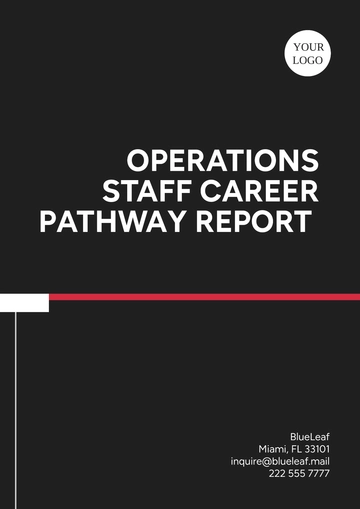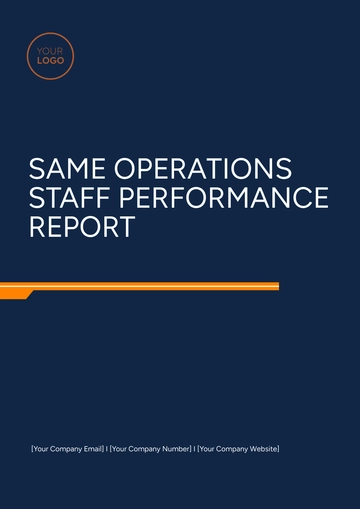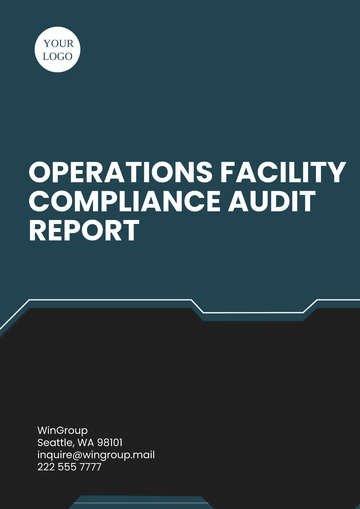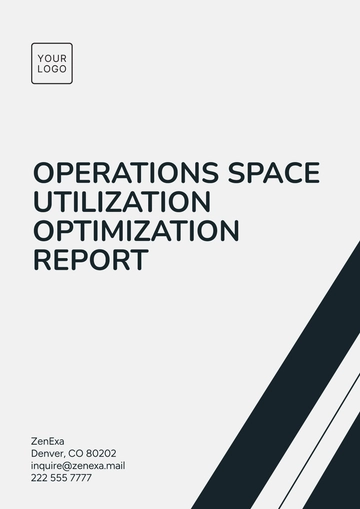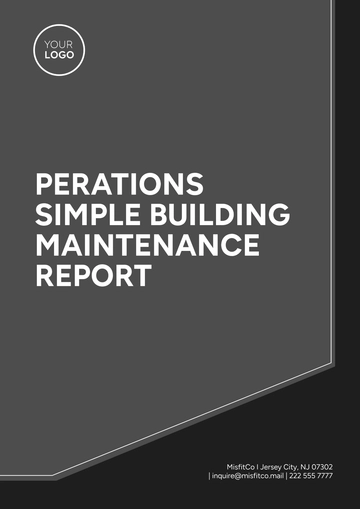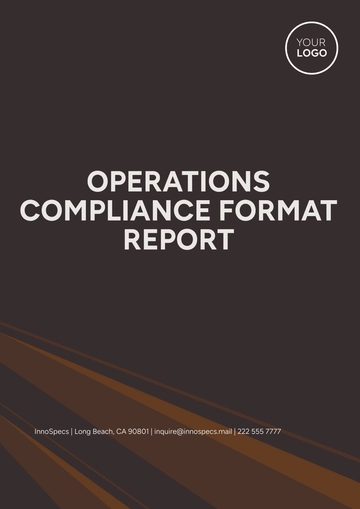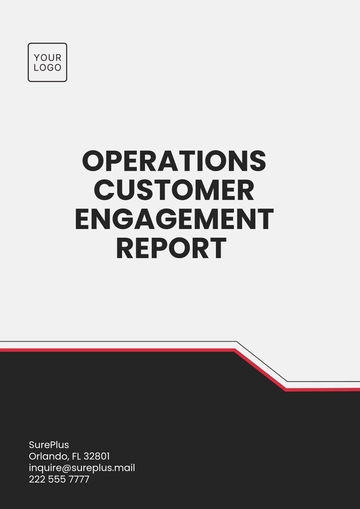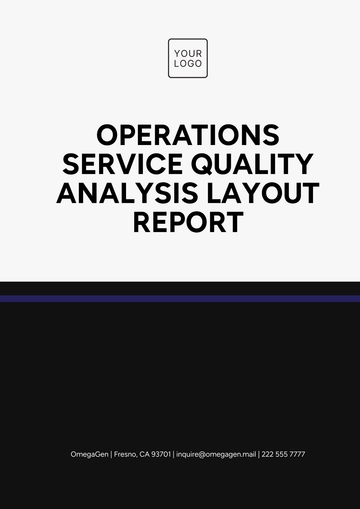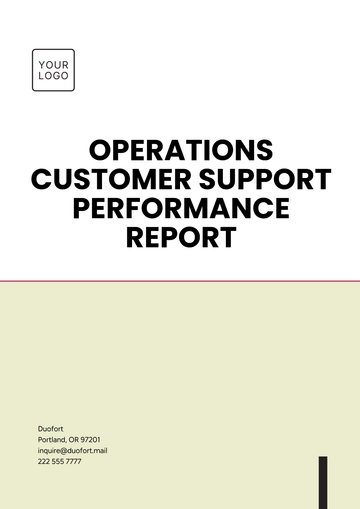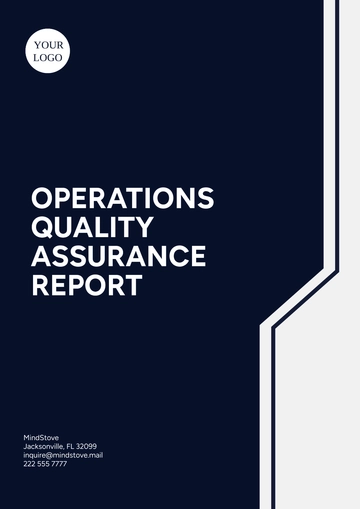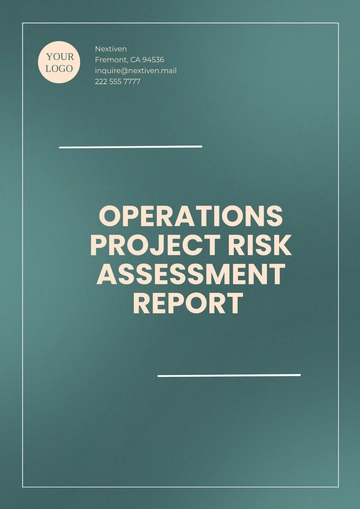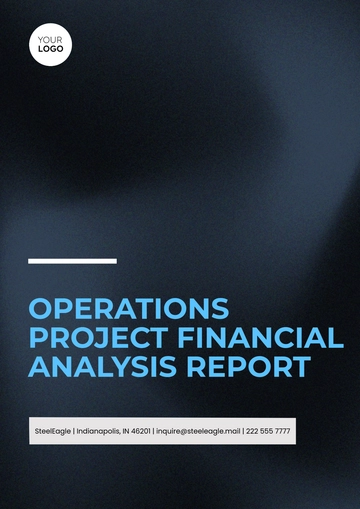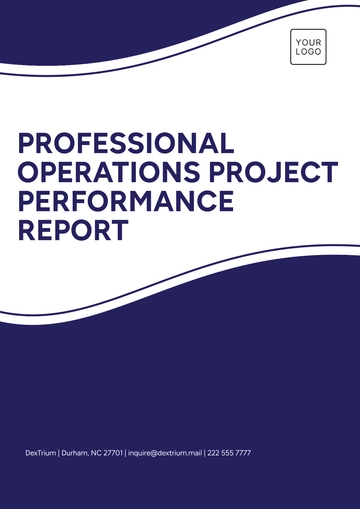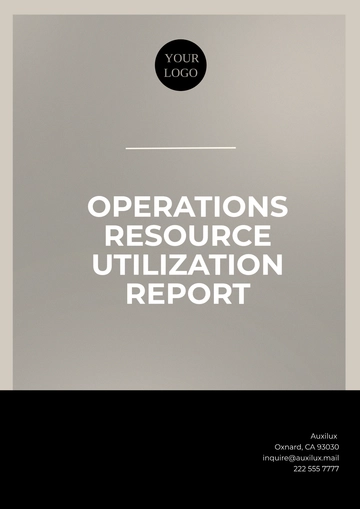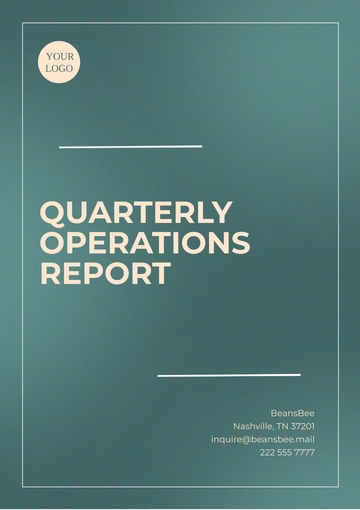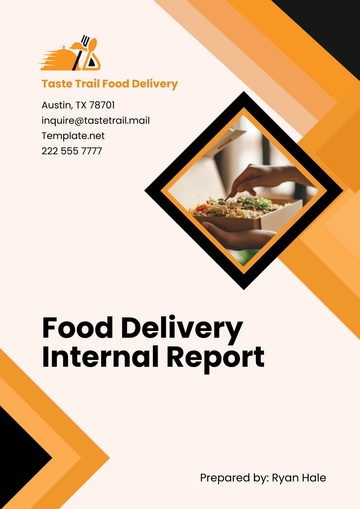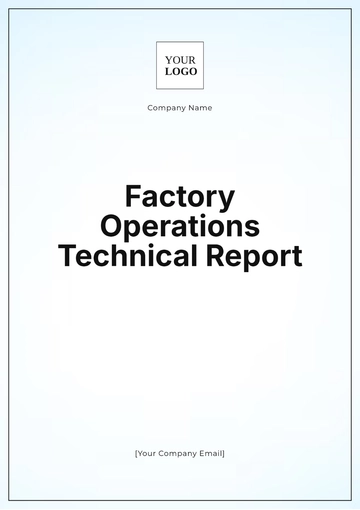Free Restaurant Operations Report
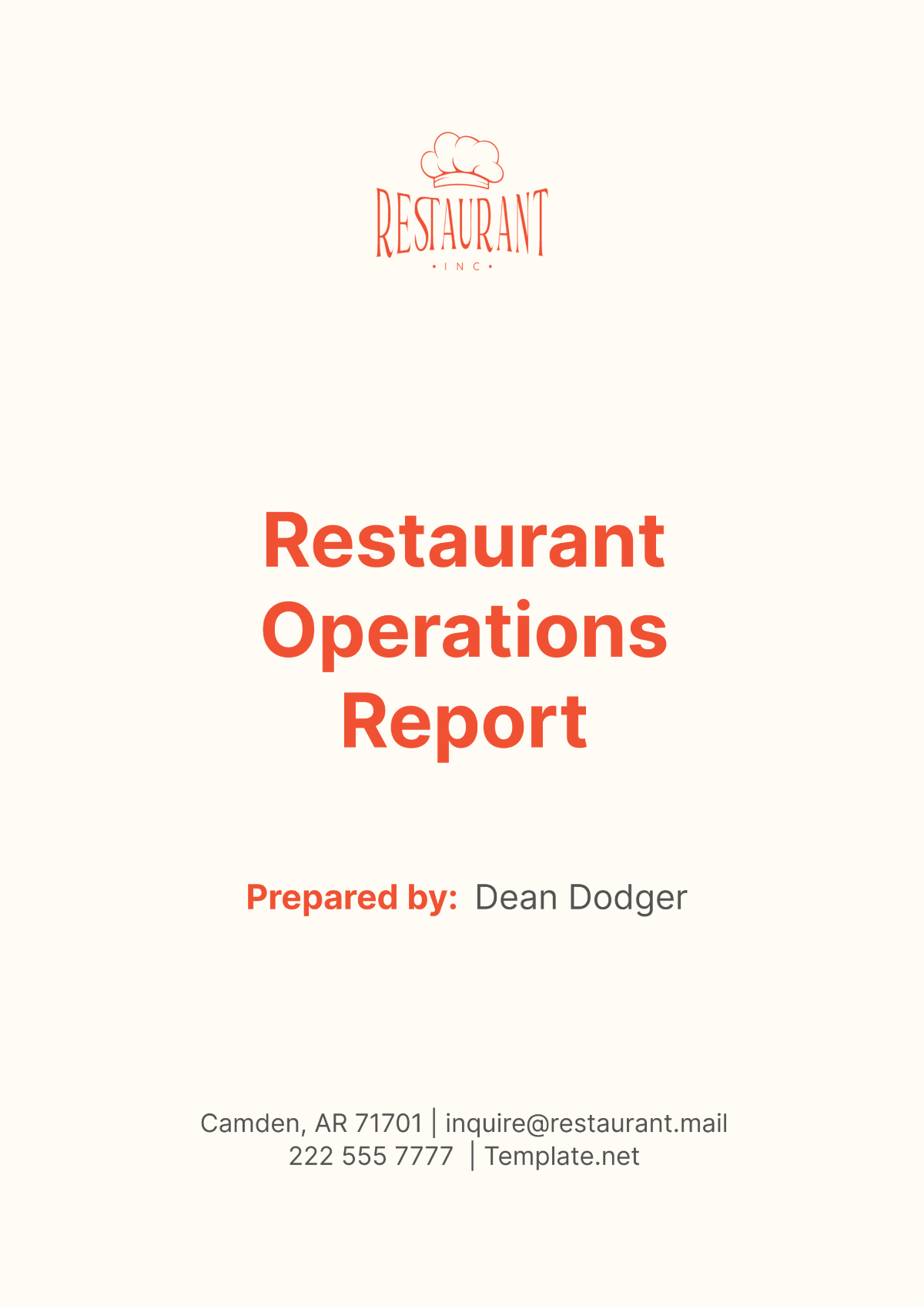
1. Executive Summary
This operations report provides an in-depth analysis of [Your Company Name]'s performance over the last quarter. Our objective is to assess various operational dimensions, including sales performance, customer traffic, menu effectiveness, and overall operational efficiency. The findings from this report will assist in strategic decision-making to enhance profitability and customer satisfaction.
Key highlights from the current quarter include a 5% increase in overall sales compared to the previous quarter, with notable improvements during peak hours due to menu optimization and marketing efforts. However, challenges such as high staff turnover and inventory management inefficiencies have been identified as areas requiring immediate attention. Strategic recommendations will focus on addressing these challenges to improve operational effectiveness and customer experience.
2. Introduction
This report is prepared by the Operations Manager of [Your Company Name] to evaluate the restaurant's operational status and identify areas for improvement. The reporting period covers the last three months, encompassing all aspects of the restaurant's daily functions from kitchen operations to customer service.
3. Operational Overview
[Your Company Name] is a full-service restaurant located in the heart of downtown, specializing in [specific cuisine type]. The restaurant has a seating capacity of 150 and operates from 10 AM to 10 PM seven days a week. Our staff structure is as follows:
Management: Includes the General Manager, Operations Manager, and Chef.
Front of House: Comprises 10 servers, 4 hosts, and 3 bartenders.
Back of House: Includes 12 cooks, 5 dishwashers, and an inventory manager.
We offer a diverse menu that includes appetizers, main courses, desserts, and a selection of beverages, catering to a wide range of dietary preferences and restrictions.
4. Performance Analysis
A. Sales Performance
Our sales analysis is summarized in the following table:
Month | Total Sales | Change from Previous Month |
|---|---|---|
January | $75,000 | |
February | $78,750 | +5% |
March | $82,687 | +5% |
The consistent increase in monthly sales is attributable to a seasonal uptick in customer visits and successful promotional campaigns. A detailed analysis of daily sales shows that weekends contribute to 60% of total sales, with an average of $5,000 in revenue per day.
B. Customer Traffic
The restaurant typically accommodates approximately 1,200 patrons each week. Recently, there has been a modest rise in the number of customers compared to the previous quarter. This increase in patronage can largely be attributed to improved marketing strategies implemented by the restaurant, along with favorable reviews and recommendations shared through word-of-mouth.
C. Menu Performance
Our menu analysis highlights the top-selling and underperforming dishes as follows:
Menu Item | Category | Average Sales per Month | Notes |
|---|---|---|---|
Spicy Tuna Roll | Appetizer | 450 units | Top-selling item |
Vegan Mushroom Soup | Appetizer | 100 units | Needs Improvement |
The Spicy Tuna Roll has received excellent customer feedback, while the Vegan Mushroom Soup has been identified as underperforming due to lower sales volumes. Customer feedback suggests that the soup lacks flavor, which could be enhanced to improve sales.
5. Operational Efficiency
A. Inventory Management
The inventory turnover rate for this quarter was 8 times, slightly below the industry average of 10 times. The table below shows a summary of key inventory items:
Item | Starting Inventory | Ending Inventory | Turnover Rate |
|---|---|---|---|
Tuna | 300 kg | 50 kg | 6 times |
Mushrooms | 150 kg | 75 kg | 2 times |
The low turnover rate for mushrooms suggests overstocking or menu misalignment, which needs to be addressed to reduce wastage and improve cost-efficiency.
B. Staff Efficiency and Productivity
Labor costs currently represent 30% of total revenue, which is within the acceptable industry standard of 28-35%. However, staff turnover is high at 20%, particularly among servers, impacting service consistency and increasing training costs. The productivity, measured as meals served per labor hour, stands at 15 meals per hour, which is optimal for our operation size.
C. Kitchen Operations
The kitchen operates efficiently with a meal preparation time averaging 12 minutes per order during peak times, and compliance with health and safety regulations has been consistently met. Equipment maintenance has been scheduled quarterly, and no significant failures have occurred in the past six months.
6. Customer Satisfaction and Feedback
At [Your Company Name], we prioritize customer feedback as a critical tool for improvement and innovation. Throughout the last quarter, we have collected customer feedback through online reviews, comment cards, and direct interviews. The analysis of this feedback is summarized below:
A. Summary of Customer Reviews and Ratings
Our restaurant has maintained an average rating of 4.2 out of 5 stars across various platforms including Yelp, Google, and TripAdvisor. The distribution of ratings over the last quarter is as follows:
Rating Stars | Number of Reviews | Percentage of Total |
|---|---|---|
5 stars | 120 | 40% |
4 stars | 90 | 30% |
3 stars | 60 | 20% |
2 stars | 20 | 7% |
1 star | 10 | 3% |
B. Feedback Themes from Comment Cards and Online Reviews
Positive Feedback: Customers frequently praised the friendly service and the quality of our signature dishes. The ambiance of the restaurant was also highlighted as particularly enjoyable.
Constructive Feedback: Some recurring themes for improvement included the waiting time during peak hours and a desire for more vegetarian options on the menu.
C. Response Strategies to Customer Complaints
We have implemented several strategic responses to address the areas of concern:
Waiting Time: Introduced a reservation system and optimized seating arrangements to reduce waiting times.
Menu Variety: Expanded our menu to include five new vegetarian dishes, which are currently under trial.
7. Financial Overview
Our financial performance is critical in driving operational decisions. This section provides a snapshot of the key financial metrics:
A. Profit & Loss Highlights
The following table summarizes our profit and loss statements for the past quarter:
Description | Amount |
|---|---|
Total Revenue | $235,437 |
Total Cost of Goods | $70,331 |
Gross Profit | $165,106 |
Operating Expenses | $95,000 |
Net Profit | $70,106 |
B. Cost Management (Fixed vs. Variable Costs)
Fixed Costs: Include rent, salaries, and utilities, accounting for 60% of total operating expenses.
Variable Costs: Include food supplies and marketing, which are directly tied to the volume of business.
C. Budget Variances
The actual expenditure surpassed the planned budget by 5%, predominantly attributable to utility costs that were greater than anticipated, along with unforeseen emergency repairs. Measures are currently being implemented to ensure that future expenditures are more closely aligned with the projections set forth in the budget forecasts.
8. Challenges and Issues
A. Description of Major Operational Challenges
Staff Turnover: We have experienced a significant turnover rate, particularly among the kitchen staff and front-of-house servers, reaching as high as 20% over the quarter. This frequent turnover disrupts operations, increases training costs, and impacts service quality. The primary reasons cited for leaving include seeking higher wages and career advancement opportunities elsewhere.
Inventory Shortages: Our restaurant faced multiple instances of inventory shortages, especially in key ingredients like seafood and specialty spices. These shortages were often due to supply chain disruptions caused by unforeseen events and delays from our primary suppliers. This not only limited our ability to offer certain popular menu items but also led to last-minute menu changes, which sometimes disappointed customers and reduced repeat visits.
B. Impact of External Factors
Economic Conditions: The economic slowdown has led to tightened spending by consumers, affecting the frequency of dining out. This economic pressure is felt across the industry but is particularly impactful for restaurants like ours that cater to middle and upper-middle-class customers. We've observed a 10% decline in average spending per visit, prompting a need to reassess our pricing strategy and value proposition.
Regulatory Changes: New health and safety regulations introduced this quarter required us to adjust our kitchen layout and invest in new equipment to comply with enhanced food safety standards. These changes were necessary but led to unexpected expenses that impacted our financial planning.
C. Internal Issues
Equipment Failures: The breakdown of our main oven was a significant disruption, occurring during one of the busiest weeks of the quarter. This issue not only affected our ability to serve a full menu but also led to longer wait times and a temporary decrease in customer satisfaction. The repair costs and operational downtime contributed to this quarter's financial variances.
Staffing Difficulties: Recruiting skilled chefs has been particularly challenging, with a noticeable gap in the availability of qualified candidates. This shortage is partly due to increased competition from new restaurants in the area, as well as our existing staff moving to higher-paying opportunities. The lack of skilled chefs has forced us to limit the complexity of new menu items, impacting our ability to innovate and respond to competitive pressures.
D. Mitigation Strategies
To address these challenges effectively, we are implementing several mitigation strategies:
Staff Retention Programs: Introduction of a more competitive wage structure, staff recognition programs, and clear pathways for career advancement to reduce turnover rates.
Supplier Diversification: We are expanding our supplier network to include additional local and regional suppliers to minimize the risk of inventory shortages. This strategy includes regular reviews of supplier performance to ensure reliability and quality standards are met.
Equipment Maintenance Plan: Instituting a comprehensive maintenance schedule for all critical kitchen equipment to prevent future breakdowns. This plan includes regular inspections and the potential leasing of backup equipment for key appliances.
Recruitment Initiatives: Partnering with culinary schools and hosting job fairs to attract a broader pool of candidates. Additionally, enhancing our employment package with better training and development opportunities to attract top talent.
9. Strategic Recommendations
To address the challenges identified and capitalize on our strengths, we recommend the following strategies:
A. Improving Sales and Profitability
Strategy | Description | Expected Outcome |
|---|---|---|
Launch Targeted Marketing Campaigns | Develop campaigns focusing on special occasions and local events. | Increase customer foot traffic by 15% and boost event bookings. |
Introduce Loyalty Programs | Implement a rewards system for repeat customers. | Enhance customer retention by 20% over the next year. |
B. Enhancing Operational Efficiency
Strategy | Description | Expected Outcome |
|---|---|---|
Staff Training Program | Revamp training procedures to include hands-on simulations. | Reduce staff turnover by 10% and improve service delivery. |
Upgrade Kitchen Equipment | Invest in high-efficiency appliances and backup systems. | Decrease cooking time by 15% and reduce equipment failures. |
C. Menu Adjustments or Marketing Promotions
Strategy | Description | Expected Outcome |
|---|---|---|
Semi-Annual Menu Revision | Regularly update the menu to phase out low-performers. | Increase menu item profitability by 25%. |
Monthly Specials Promotion | Offer new dishes monthly to attract interest and feedback. | Attract 30% more visits during promotion months. |
D. Additional Strategic Initiatives
Strategy | Description | Expected Outcome |
|---|---|---|
Enhance Online Presence | Revamp the website and increase social media engagement. | Increase online reservations by 40%. |
Community Engagement | Participate in local events and sponsor community projects. | Build brand awareness and community ties, increasing local customer base by 20%. |
10. Conclusion
This report has provided a comprehensive analysis of [Your Company Name]'s operations over the past quarter. While we have seen improvements in sales and customer satisfaction, challenges such as high staff turnover and inventory management issues need to be addressed. The strategic recommendations outlined above are designed to tackle these issues head-on, positioning [Your Company Name] for sustained growth and success in the competitive restaurant industry.
- 100% Customizable, free editor
- Access 1 Million+ Templates, photo’s & graphics
- Download or share as a template
- Click and replace photos, graphics, text, backgrounds
- Resize, crop, AI write & more
- Access advanced editor
Streamline your restaurant's reporting with Template.net's Restaurant Operations Report Template. This fully customizable and editable tool, enhanced by our AI Editor Tool, provides a comprehensive format for documenting daily operations, helping you monitor performance, identify issues, and implement improvements efficiently. Essential for maintaining optimal operations and driving business success.
You may also like
- Sales Report
- Daily Report
- Project Report
- Business Report
- Weekly Report
- Incident Report
- Annual Report
- Report Layout
- Report Design
- Progress Report
- Marketing Report
- Company Report
- Monthly Report
- Audit Report
- Status Report
- School Report
- Reports Hr
- Management Report
- Project Status Report
- Handover Report
- Health And Safety Report
- Restaurant Report
- Construction Report
- Research Report
- Evaluation Report
- Investigation Report
- Employee Report
- Advertising Report
- Weekly Status Report
- Project Management Report
- Finance Report
- Service Report
- Technical Report
- Meeting Report
- Quarterly Report
- Inspection Report
- Medical Report
- Test Report
- Summary Report
- Inventory Report
- Valuation Report
- Operations Report
- Payroll Report
- Training Report
- Job Report
- Case Report
- Performance Report
- Board Report
- Internal Audit Report
- Student Report
- Monthly Management Report
- Small Business Report
- Accident Report
- Call Center Report
- Activity Report
- IT and Software Report
- Internship Report
- Visit Report
- Product Report
- Book Report
- Property Report
- Recruitment Report
- University Report
- Event Report
- SEO Report
- Conference Report
- Narrative Report
- Nursing Home Report
- Preschool Report
- Call Report
- Customer Report
- Employee Incident Report
- Accomplishment Report
- Social Media Report
- Work From Home Report
- Security Report
- Damage Report
- Quality Report
- Internal Report
- Nurse Report
- Real Estate Report
- Hotel Report
- Equipment Report
- Credit Report
- Field Report
- Non Profit Report
- Maintenance Report
- News Report
- Survey Report
- Executive Report
- Law Firm Report
- Advertising Agency Report
- Interior Design Report
- Travel Agency Report
- Stock Report
- Salon Report
- Bug Report
- Workplace Report
- Action Report
- Investor Report
- Cleaning Services Report
- Consulting Report
- Freelancer Report
- Site Visit Report
- Trip Report
- Classroom Observation Report
- Vehicle Report
- Final Report
- Software Report
